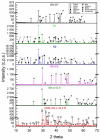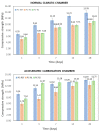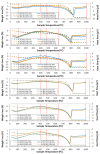Accelerated Carbonation of Vibro-Compacted Porous Concrete for Eco-Friendly Precast Elements
- PMID: 37109831
- PMCID: PMC10141858
- DOI: 10.3390/ma16082995
Accelerated Carbonation of Vibro-Compacted Porous Concrete for Eco-Friendly Precast Elements
Abstract
This research studied the effect of accelerated carbonation in the physical, mechanical and chemical properties of a non-structural vibro-compacted porous concrete made with natural aggregates and two types of recycled aggregates from construction and demolition waste (CDW). Natural aggregates were replaced by recycled aggregates using a volumetric substitution method and the CO2 capture capacity was also calculated. Two hardening environments were used: a carbonation chamber with 5% CO2 and a normal climatic chamber with atmospheric CO2 concentration. The effect of curing times of 1, 3, 7, 14 and 28 days on concrete properties was also analysed. The accelerated carbonation increased the dry bulk density, decreased the accessible porosity water, improved the compressive strength and decreased the setting time to reach a higher mechanical strength. The maximum CO2 capture ratio was achieved with the use of recycled concrete aggregate (52.52 kg/t). Accelerate carbonation conditions led to an increase in carbon capture of 525% compared to curing under atmospheric conditions. Accelerated carbonation of cement-based products containing recycled aggregates from construction and demolition waste is a promising technology for CO2 capture and utilisation and a way to mitigate the effects of climate change, as well as promote the new circular economy paradigm.
Keywords: CO2 uptake; accelerated carbonation; construction and demolition waste; porous concrete.
Conflict of interest statement
The authors declare that they have no known competing financial interest or personal relationships that could have influenced the work reported in this paper.
Figures








References
-
- Xi C., Cao S.J. Challenges and Future Development Paths of Low Carbon Building Design: A Review. Buildings. 2022;12:163. doi: 10.3390/buildings12020163. - DOI
-
- Kisku N., Joshi H., Ansari M., Panda S.K., Nayak S., Dutta S.C. A Critical Review and Assessment for Usage of Recycled Aggregate as Sustainable Construction Material. Constr. Build. Mater. 2017;131:721–740. doi: 10.1016/j.conbuildmat.2016.11.029. - DOI
-
- Ibn-Mohammed T., Greenough R., Taylor S., Ozawa-Meida L., Acquaye A. Operational vs. Embodied Emissions in Buildings—A Review of Current Trends. Energy Build. 2013;66:232–245. doi: 10.1016/j.enbuild.2013.07.026. - DOI
-
- Li L. Integrating Climate Change Impact in New Building Design Process: A Review of Building Life Cycle Carbon Emission Assessment Methodologies. Clean. Eng. Technol. 2021;5:100286. doi: 10.1016/j.clet.2021.100286. - DOI
-
- Grynning S., Gradeci K., Gaarder J.E., Time B., Lohne J., Kvande T. Climate Adaptation in Maintenance Operation and Management of Buildings. Buildings. 2020;10:107. doi: 10.3390/buildings10060107. - DOI
LinkOut - more resources
Full Text Sources

